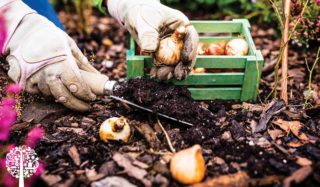There’s always something to do in the garden! Every month, there are new things to plant, prune, and nurture. September’s a hectic month. It’s time to start preparing for winter, thinking about spring, and cultivating summer blooms.
Spring Bulbs
It’s time to start planning where those daffodils and tulip bulbs will pop up next spring. Garden centers are already stocking shelves with spring bulbs or making them available through mail order. Store them in a cool place and wait until after Canadian Thanksgiving to plant, but start stocking up.
Planting
September’s a great time to transplant and divide perennials because the soil is warm; they’ll establish before the cold weather sets in. Spinach and winter kale can be planted at the beginning of the month for harvest by Thanksgiving. And make sure to plant broad-leaved and needled evergreens and garlic by the end of the month.
Seeds
Foxglove, poppy, and echinacea seeds can be sown directly into the ground for next year. By the end of the month, sunflowers will be fading. Keep the seed heads and let them dry out to feed the birds in winter or to sow next spring.
Summer Bulbs
Summer bulbs like gladiolas, eucomis, canna, and oriental lilies (especially if planted in containers) should be lifted by the end of the month and stored in a cool dark place until re-planting in spring.
Pruning
Prune summer raspberry bushes, blackberries, and blueberries down to ground level and tie together this year’s canes to support next year’s crop. You can prune other shrubs like hydrangea and hibiscus after flowering.
Vegetables And Fruits
Everbearing strawberries are sending out runners (stems with leaves). Peg the runners into the ground to root for next year. After harvesting the last summer vegetables, mulch what’s left back into the bed to boost the soil’s nitrogen. Pumpkins and squashes are ripening and need sun. Remove the leaves on the stock around the fruit and prop them off the ground so that rain won’t cause rot.
Wintering Over
When nighttime temperatures drop below 10°C, bring in all the tropical houseplants that have been sunning on the patio or balcony all summer. This is a good time to re-pot them. Then, towards the end of the month, it’s time to start thinking about wintering over geraniums, coleus, and other annuals.
Watering
September watering is tricky. Nights are cool, days are warm, and moisture is retained in the soil. If something looks or feels dry, go ahead and water. This is also when newly planted trees need extra water, and spring shrubs like rhododendrons, azaleas, and camellias as they begin setting buds for next spring.
Deadheading For Fall Color
Keep deadheading dahlias, roses, penstemons, and other late blooming perennials and annuals such as geraniums and fuchsia to get one last burst of color. Early September is a great time to plant fall chrysanthemums, ornamental kale, pansies, and other fall favorites for color right through Halloween.
Stop Fertilizing Summer Annuals And Perennials
Things are winding up their natural cycles, and organic fertilizer will liven them up and disrupt this rhythm; they may not return as healthy next year.
Around the world, September is a hive of activity in the garden. In New Zealand and Australia, winter is ending. So it’s time to plant dahlias and summer bulbs, divide perennials, prune back early blooming magnolias, plant warm weather vegetables like zucchini and tomatoes, and mulch in the winter compost to give nutrients and energy to the soil.
Wherever you live, gardening in September is about new seasons and enjoying the garden life.
Stay tuned for October’s garden tips as we garden together!


